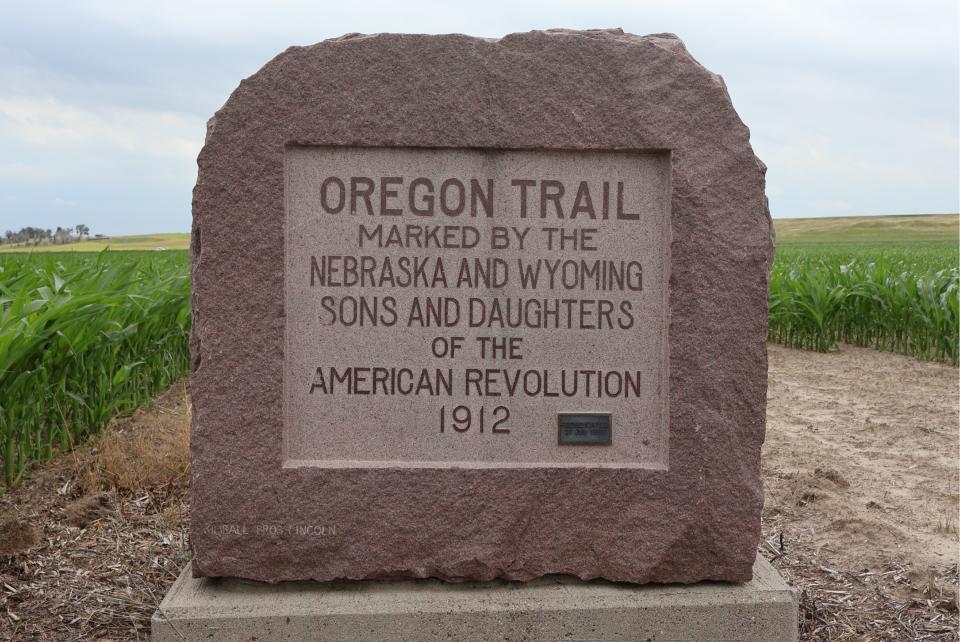Historical Monuments on the Wyoming-Nebraska Border
By Kylie Louise McCormick
Earlier this month, I visited the Oregon Trail state-boundary monuments between Nebraska and Wyoming. The two monuments sit only a couple of hundred yards apart from one another with one placed on the shoulder of a Nebraska public road and the other on the state border sitting on private land.

The granite stones were set in place in December 1912 and, on April 4, 1913, around 400-500 people gathered in the small town of Henry, Nebraska to parade down the road about two miles, hike through an alfalfa field and watch the unveiling of the large Oregon Trail Nebraska-Wyoming Boundary Monument. The red granite monument was placed by the Wyoming and Nebraska Sons and Daughters of the American Revolution, as well as the Nebraska State Oregon Trail Memorial Commission. The Boy Scouts of Scottsbluff, Nebraska escorted the procession, while the boys’ band from Torrington, Wyoming played patriotic tunes like Yankee Doodle. In all the monument cost $350, or around $11,000 today. The Wyoming groups raised $100 for the effort, while Nebraska provided the balance. The unveiling was largely organized by the Wyoming groups, but Nebraska led the efforts to procure the granite and set the stones in place.
In 1912, there was some debate as to where to place the monument. The Nebraska Oregon Trail Memorial Commission had been placing monuments on the public road nearest to the trail, but that road was the connection road between Lyman, Nebraska and Henry, Nebraska and about a quarter of a mile away from the border with Wyoming. The groups in Wyoming obviously favored putting the monument on the border so that it would touch both states. It was ultimately decided to place two stones, one on the public road and funded by the State of Nebraska, and another in partnership with Wyoming on private land. Grace Raymond Hebard described the stone placed by the State of Nebraska as, “a stone ‘finder’ about five feet high, which is on the main road. […] Near the stone may be found a gate leading to the boundary monument.”
In 1913, the monument stood in an alfalfa field; today it sits barely visible in a corn field. There is no longer a gate, but fortunately the current landowner is gracious and allows people to walk through his crops and to the monument. Back in June, while driving south of Henry and trying to find the monuments, I was fortunate to run into a local, Steven Brutthouer, who was familiar with the landowners because of his work on the canals in the area. He knew of the grey granite monument on the public road, but despite being born less than 30 miles down the road in Scottsbluff, he didn’t know about the large red granite monument on the state border. Although it was barely visible from the state marker, Steven spotted the red granite with binoculars and was kind enough to reach out to the landowner for permission so I could traipse out into the field this July.
The push and pull of public versus private, and access versus historical accuracy remains central to discussions of memorializing historic trails. For instance, the trail taken by the Pony Express Re-ride sticks to public roads, diverging off the historic trail in areas where it is blocked by fences and private ownership. Historians like Randy Brown work hard to establish and maintain relationships with landowners, so he can mark the actual locations of trails across the west. The work continues to be done in partnership between county and state governments, federal agencies, and of course, volunteer groups like the Oregon-California Trails Association and the Daughters of the American Revolution.
On July 28th, I will be sharing the complete story of these two boundary monuments and the partnerships between Wyoming and Nebraska, as part of the Oregon-California Trails Association’s Annual Convention, held in Gering, Nebraska this year. Last year, the conference was held in Casper, Wyoming. Just as they were in 1913, the historic trails continue to be an opportunity for Wyoming to work with our neighboring states and collaborate on our efforts to remember and memorialize our past. If you are interested in the historic trails, definitely check out this year’s convention!
Kylie Louise McCormick is an assistant editor of WyoHistory.org
Read marking the Past: A History of Wyoming’s Historical Markers
Read The Pony Express in Wyoming
